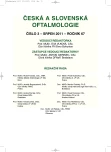DMEK (Descemet Membrane Endothelial Keratoplasty) – Early and Late Postoperative Complications
Authors:
Z. Hlinomazová; M. Horáčková; L. Pirnerová
Authors‘ workplace:
Oční klinika Lékařské fakulty MU a Fakultní nemocnice, Brno, přednosta prof. MUDr. Eva Vlková, CSc.
Published in:
Čes. a slov. Oftal., 67, 2011, No. 3, p. 75-79
Category:
Original Article
Overview
The authors refer to the cross-sectional study of surgical technique, operation, early and late postoperative complications in the first 30 patients after DMEK (Descemet membrane endothelial keratoplasty).
Setting and methods:
The group comprised 17 women and 13 men with an average age of 62 years (SD 12.2). The follow up period 1–12 months, average 4.2 months. The DMEK were indicated in patients with boullous keratopathy, Fuchs’ endothelial dystrophy and endothelial insufficiency after repeated corneal transplantation.
Results:
In half of the patients had to undergo DMEK surgery and the other half DMEK surgery combined with cataract surgery. One patient dropped from the Descemet membrane transplantation because of insufficient donor cornea and was indicated re DMEK.
Surgical complications:
4 times difficulty of the striping of Descemet membrane, 2 times operating decentration plates, 1 times bleeding the implementation of peripheral iridectomy. Early postoperative complications in 10 patients: 3x pupillary block, 1x fibrin reaction in anterior chamber, 1 curled strip of anterior chamber in 1st postoperative day, 3x coiled plate with localized corneal oedema, 1 residual membrane size 2 x 2 mm Descemet slats off the optical axis. Late postoperative complications were recorded in a total of 7 patients. 4 occurred secondary glaucoma and 2 corneal edema localized outside the optical zone. Once there was a bridging of traction plates.
Visual acuity in uncomplicated patients were arranged within 21 days after surgery, patients with complications within 3 months. 1 times was made re DMEK rolled plates with the removal of the anterior chamber, 3 by 5 days to reposition scrolling border membranes by repeated big bubble technique.
Conclusion:
DMEK seems like a good option to remedy endothelium defects. About 70 % of patients have fewer complications when used alone DMEK than cataract surgery combined with DMEK. For knowledgeable surgeon, starting with Descemet membrane transplantation, it is appropriate to separate transplants without combination with other procedures (cataract surgery, iriedktomy). Laser iridotomies before operation seems an appropriate procedure to avoid bleeding while surgery.
Key words:
DMEK, cornea, transplantation
Sources
1. Bahar, I., Kaiserman, I., McAllum, P., et al.: Comparison of posterior lamellar keratoplasty techniques to penetrating keratoplasty. Ophthalmology, 115, 2008; 9:1525–33.
2. Balachandran, C., Ham, L., Verschoor, C.,A. et al.: Spontaneous corneal clearance despite graft detachment in descemet membrane endothelial keratoplasty. Am J Ophthalmol, 148, 2009; 2: 227–234.
3. Busin, M., Patel, A.,K., Scorcia, V., Galan, A. et al.: Stromal support for Descemet’s membrane endothelial keratoplasty. Ophthalmology, 117, 2010; 12: 2273–2277. Ophthalmology, 117, 2010; 12: 2273–2277.
4. Cursiefen, C., Kruse, F.,E.: DMEK: Descemet membrane endothelial keratoplasty Ophthalmologe, 107, 2010 ; 4: 370–6.
5. Dapena, I., Ham, L., Melles, G., R.: Endothelial keratoplasty: DSEK/DSAEK or DMEK – the thinner the better? Curr Opin Ophthalmol, 20, 2009; 4: 299–307.
6. Dapena, I., Moutsouris, K., Droutsas, K. et al.: Standardized „no-touch“ technique for descemet membrane endothelial keratoplasty. Arch Ophthalmol, 2011, 129; 1: 88–94.
7. Da Reitz Perena, C., Guerra, F.,P., Price, F.,W., Jr. et al.: Descemet’s membrane automated endothelial keratoplasty (DMAEK): visual outcomes and visual quality. Br J Ophthalmol, 2010, Dec. 22. [Epub ahead of print].
8. Ham, L., van der Wees, J., Melles, G.,R.: Causes of primary donor failure in Descemet membrane endothelial keratoplasty. Am J Ophthalmol, 145, 2008; 4: 639–644.
9. Ham, L., Dapena, I., van der Wees, J., et al.: Secondary DMEK for poor visual outcome after DSEK: donor posterior stroma may limit visual acuity in endothelial keratoplasty.Cornea. 29, 2010; 11: 1278–1283.
10. Chen, E., S., Terry, M., A., Shamie, N. et al.: Descemet-stripping automated endothelial keratoplasty: six-month results in a prospective study of 100 eyes. Cornea, 27, 2008; 5: 514–520.
11. Melles, G.,R., Eggink, F.,A., Lander, F. et al.: A surgical technique for posterior lamellar keratoplasty. Cornea, 17, 1998; 6: 618–626.
12. Melles, G., R., Wijdh, R., H., Nieuwendaal, C., P.: A technique to excise the Descemet membrane from a recipient cornea (descemetorhexis). Cornea, 23, 2004; 3: 286–288.
13. Melles, G., R., Lander, F., Nieuwendaal, C.: Sutureless, posterior lamellar keratoplasty: a case report of a modified technique. Cornea, 21, 2002; 3: 325–327.
14. Nieuwendaal, C., P., Lapid-Gortzak, R., van der Meulen I., J. et al.: Posterior lamellar keratoplasty using descemetorhexis and organ cultured donor corneal tissue (Melles technique). Cornea, 25, 2006; 8: 933–936.
15. Price, F., W. Jr., Price, M., O.: Descemet’s stripping with endothelial keratoplasty in 50 eyes: a refractive neutral corneal transplant. J Refract Surg, 21, 2005; 4: 339–345.
16. Studeny, P., Farkas, A., Vokrojova, M., et al.: Descemet membrane endothelial keratoplasty with a stromal rim (DMEK-S). Br J Ophthalmol, 94, 2010; 7: 909–914.
17. Tappin, M.: A method for true endothelial cell (Tencell) transplantation using a custom –made cannula for the treatment of endothelial cell failure. Eye, 21 2007; 6: 775–779.
18. Williams KA, Muehlberg SM, Lewis RF, Coster DJ.: How successful is corneal transplantation? a report from the Australian Corneal Graft Register. Eye, 9,1995; 2: 219–227.
Labels
OphthalmologyArticle was published in
Czech and Slovak Ophthalmology

2011 Issue 3
Most read in this issue
- DMEK (Descemet Membrane Endothelial Keratoplasty) – Early and Late Postoperative Complications
- Lasik after Corneal Ulcer
- The Reconstruction of Conjunctival Socket after Enucleation of the Eye in Past – Two Possibilities of Surgical Solution
- Lyell’s Disease – a Case Report
